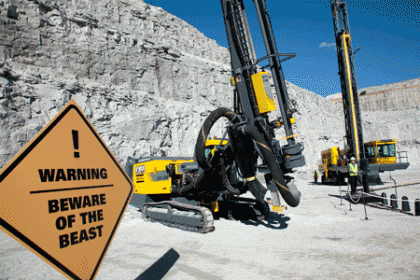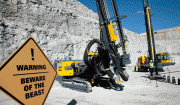The beast and the viper show their high-tech teeth in Australia
More than 100 representatives of 60 mining and contracting companies in Australia attended the recent launch of the new generation SmartRig ROC D65 (profiled as The Beast), and its large-hole cousin the new Pit Viper 235 series. These rigs – and the technology they represent – take surface drilling to a new level.
The first SmartRig series for DTH drilling and the first Pit Viper 235 for rotary drilling have made their debut down under ? and that makes Australia the first country outside of Europe and North America to get the benefit of these Atlas Copco RCS-based innovations.
At this action-packed launch on May 20 these rigs highlighted not only the advantages of satellite and mine plan-linked navigation as well as automated feed alignment, rod handling and rig set-up, but also fuel saving and maintenance innovations.
These features and more are shared by both rigs, but also by Atlas Copco?s underground and exploration equipment.
?It?s a commitment that we?ve made to standardize our support capabilities and our operating platform, not just for our surface drilling range but also our underground products,? commented Peter Barnett, Business Line Manager, Atlas Copco. ?The common technology platform and numerous standard parts produce training and operating benefits; it means familiarity with a machine can be transferred across a range.?
Impressive automation
Barnett described a visit to Boliden?s Aitik copper mine in northern Sweden during extensive testing of the SmartRig ROC D65 as ?an eye-opener?. ?The auto-rod adding with the system racking its own rods while the operator was standing next to me was seriously impressive,? he said.
Dustin Penn, Product Line Manager for blast-hole drills, said the Pit Viper series of large blast-hole drill rigs (for holes up to 400 mm/16 inch diameter) had been very well received since the introduction of the PV-351 at MINExpo in Las Vegas a decade ago. Ongoing development culminated in the Pit Viper 235 launched at MINExpo in 2008.
?When we started out on this project a few years ago the intention was to replace our very successful DML product and we had several targets in mind with the Pit Viper,? he added. ?They were simply to maximize productivity and minimize non-drilling time while maximizing fuel efficiency and improving the maintainability of the machine.
?These drills transport and set up faster, they are capable of true single-pass production drilling and they are the safest and easiest-to-maintain machines in their class.
?There are several other technologies that we?ve developed ranging from the cable pull-back system that has replaced the previous chain pullback, which has improved safety and helped to capture our faster feed speeds, to the new break-out auxiliary wrench for rod joint breaks.?
?Air compressors consume thirty percent of their rated power in standby mode, so when the operator switches the air compressor off it is still turning and using horsepower,? Penn continued. ?So what we?re doing with this clutch is physically disconnecting the air compressor from the engine and saving quite a bit of horsepower when you?re changing rods, tramming, levelling, or idling. You save some of that horsepower and we?ve seen up to fifteen percent in fuel consumption reductions.?
Spotlight on training
Atlas Copco?s new generation drill rigs will still be controlled, for the most part, by operators so the company?s latest training initiatives were also put under the spotlight. These include the Master Driller multi-tier global training programme and advanced simulator training using an Atlas Copco designed and certified rig module and software. Both are due to be introduced in Australia in September this year.
Positive reaction
The reaction from the attendees was positive. John Ivanovski, Project Manager, Drilling, of Rock Australia, said the company had just bought its first SmartRig ROC D65 and had high hopes for its performance at a nickel mine.
?It?s our first SmartRig, and hopefully the first of many,? he said, adding ?it?s getting very hard to get skilled operators and these rigs reduce the training time, and the knowledge and expertise that we need to operate the machines because they?re taking care of a lot of it for us.
? There?s a lot less risk of damage to the rigs, like squashed rods and bits and pieces like that. So there are some huge cost benefits there for us.?
Ian Rose of Yilgarn Drill and Blast had some reassurance for Rock and other new SmartRig owners. He said the company had three SmartRig units deployed in Western Australia, the ?oldest? having delivered three years and 6 500 hours of service.
Rose said the benefits of the technology and new design features highlighted at the launch were a reality. ?Probably the most significant benefits I?ve seen to date are the availability of the machines, and the ease of maintenance,? he said. ?Being able to diagnose faults quickly and easily is obviously a key advantage, and with new operators it is just easier to teach them how to get the most out of the drill rig.?
Exceptional run
?We?ve had an exceptional run with three of these rigs,? added Rose. ?The availability, maintainability and performance has been a real advantage for us in a competitive contract drilling market. We haven?t gone below ninety five percent availability.?
Olav Kvist, Product Manager, Automation for Atlas Copco, pointed out that the SmartRig brings precision in drilling, documentation, and repeatability. ?Without that there is no need to even try to do continuous improvement. Of course, there is also the safety aspect ? miners want to remove people from the bench; they want to get rid of service trucks from a working pit. That?s a safety risk that can be removed from the equation. Sure, they need to be there surveying the first time, but not repeatedly to assess and monitor how they are drilling.?
Epiroc operated under the trademark “Atlas Copco” prior to January 1, 2018.



Here:
Us: